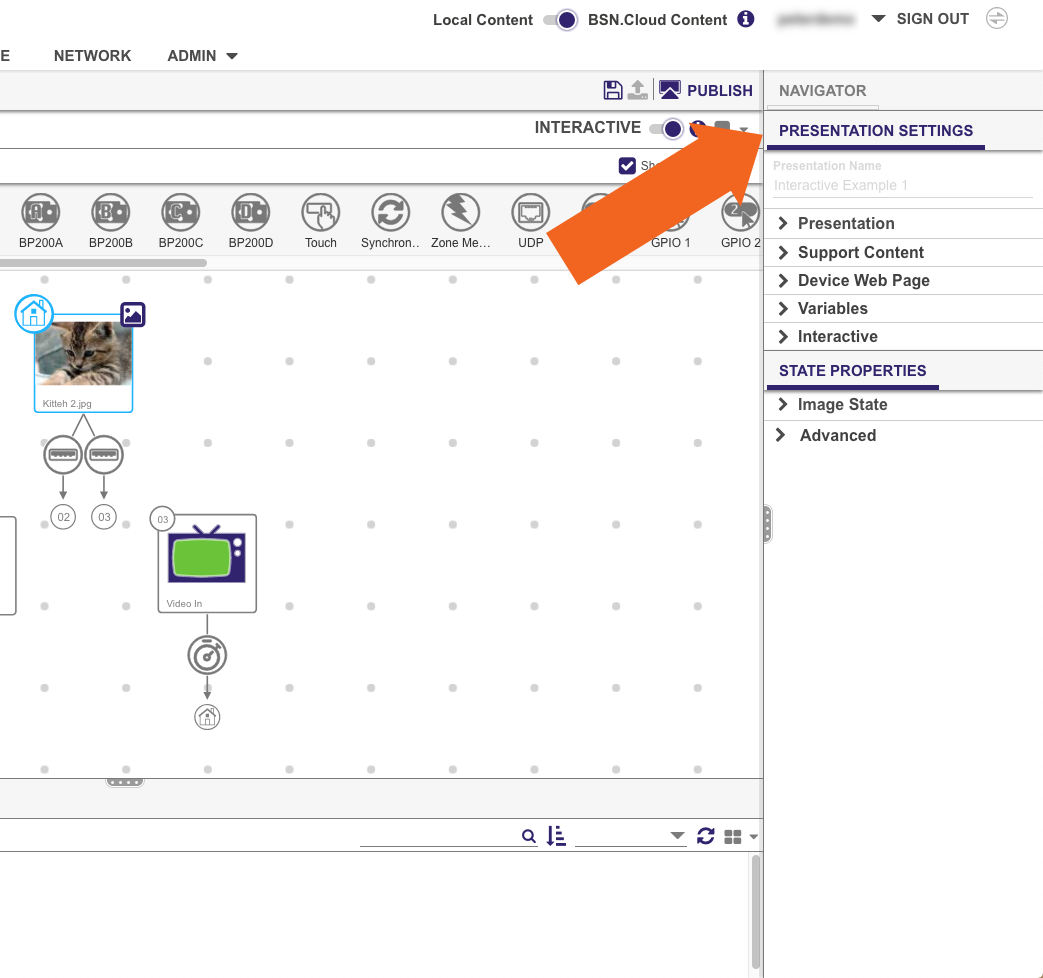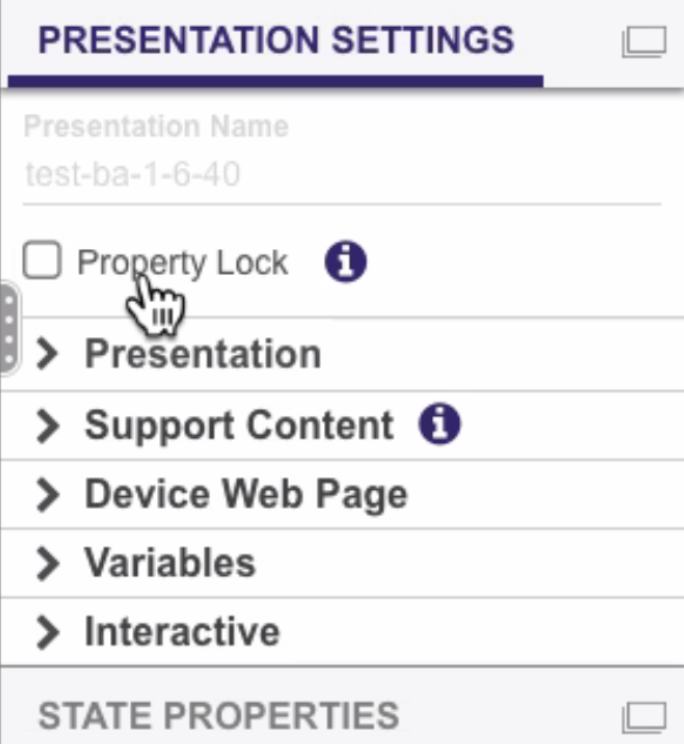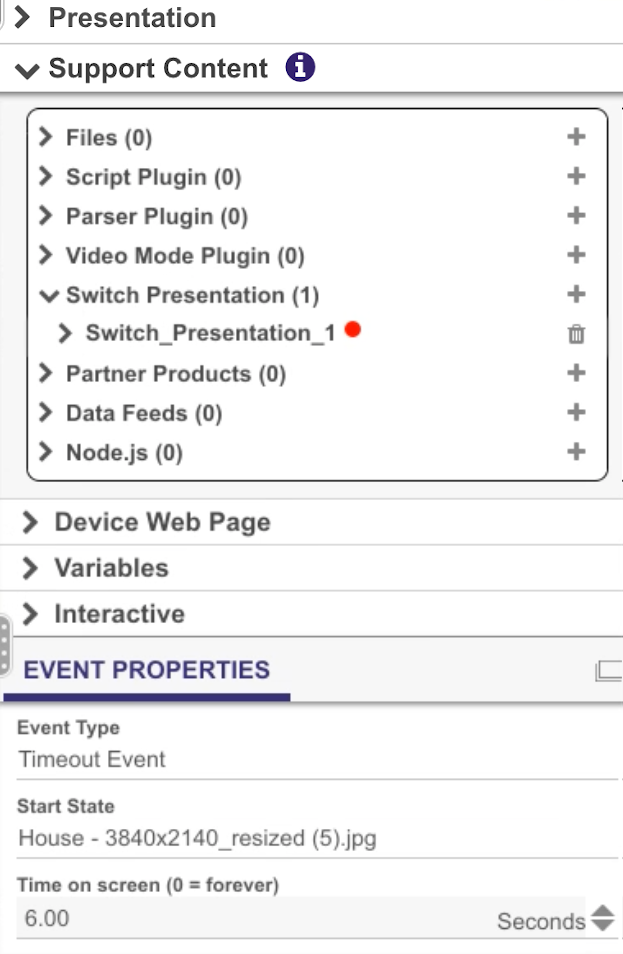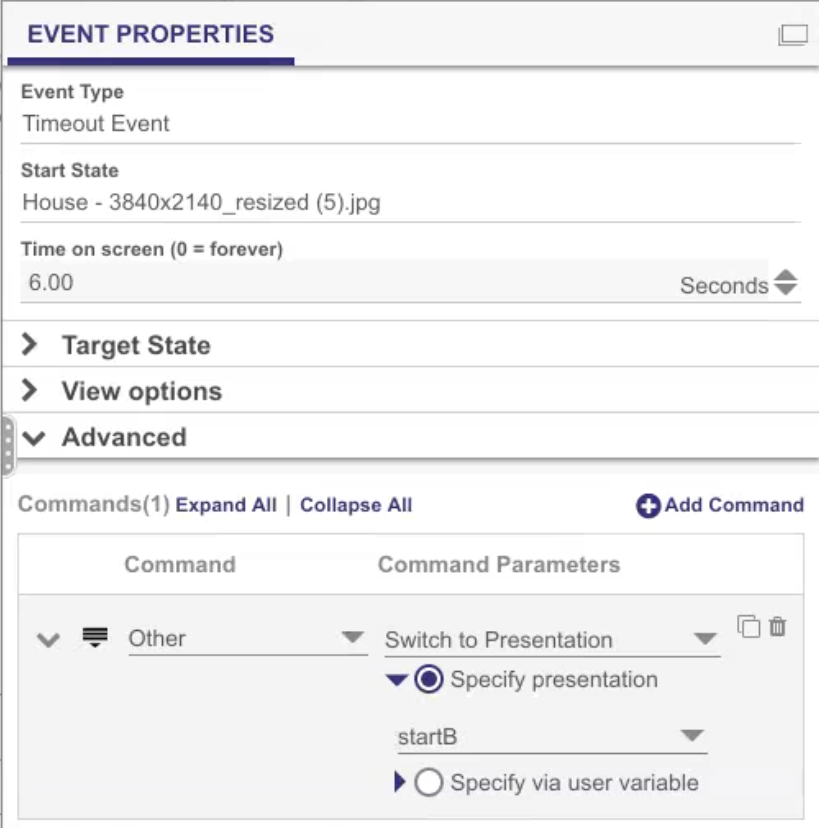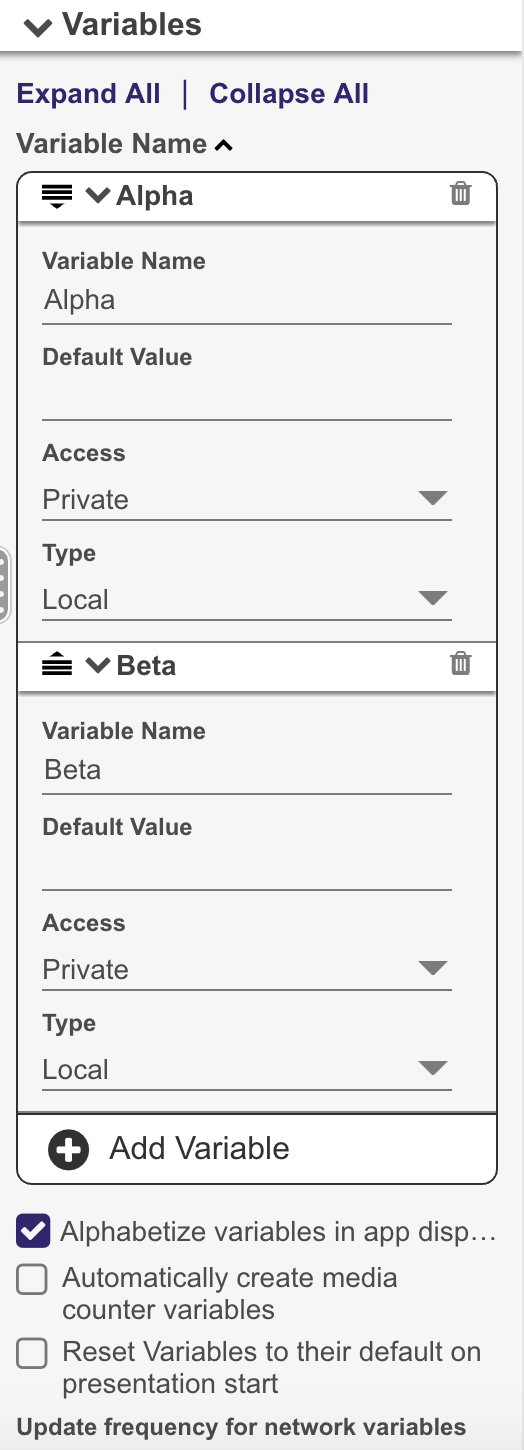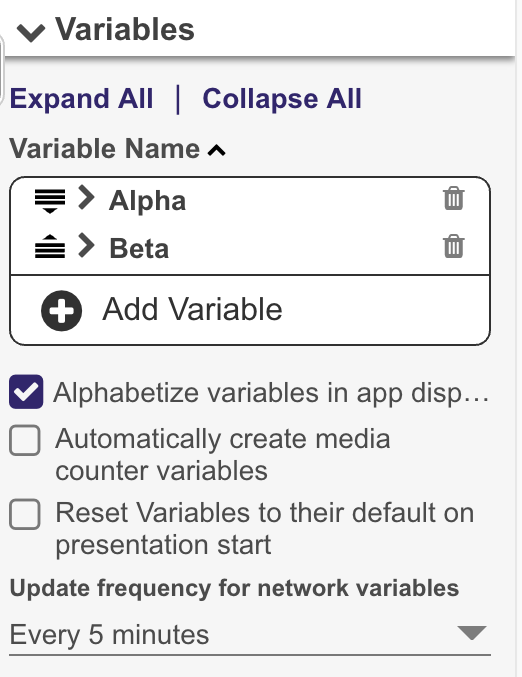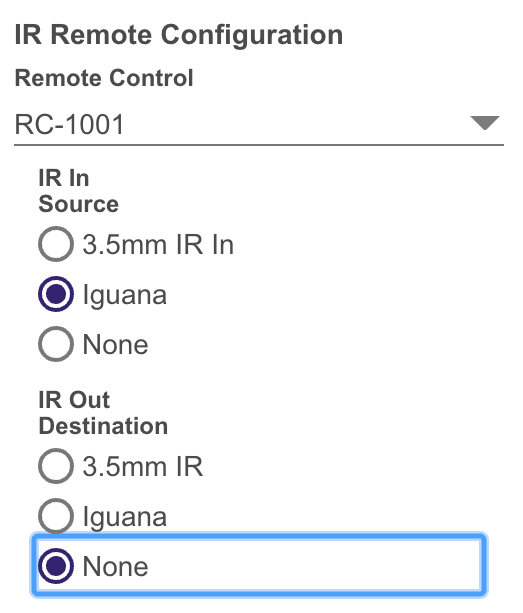| Note |
|---|
When the Property Lock setting changes, there can be a reporting delay of up to 10 minutes between the OS, BSN, and the BrightAuthor:connnected UI. During the reporting delay, the UI may be out of sync with the player. If you change the properties during this period, the UI will accept the changes and post them to BSN. BSN will store and deliver those settings to the player, but the player will not respond to them (the properties of the player will be locked). The player will not apply your changes until the settings handler has been reenabled by the presentation. |
Presentation
Use this section to edit video and audio output settings.
Display
- Connection Type: Select the video connector that connects the player to the display.
- Target Resolution: Choose a resolution that is compatible with your monitor. See here for a list of all available video modes.
- Force Resolution : Check this box to have the player output the selected resolution even if the display reports over HDMI® that it does not support it. If this box is unchecked, the player will attempt to use the selected Target Resolution, but will then fall back to the highest resolution supported by the display if it is unsupported.
Anchor presentation presentation - Enable YCbCr 10-bit output : Check this box to output a 10-bit color video signal to the connected display. See the video encoding FAQ for more details on supported 4K color spaces and bit depths.
- Enable Full Resolution Graphics: Check this box to enable full-resolution for the selected Target Resolution. When this box is checked, the graphics plane (images, text, HTML animations, etc.) is rendered at the same size as the video output, rather than being upscaled to the output resolution after rendering. This option is only available for certain video modes larger than 1920x1200; all smaller video modes user full-resolution graphics automatically. This setting is subject to additional restrictions based on the resolution and player model-see here for full details.
- Enable Dolby Vision : Check this box to enable Dolby Vision on the video output. The presentation will be limited to a single video zone with this option enabled. This option is supported on XT244 and XT1144 models only.
- Target Frame Rate : Choose a frame rate that is compatible with your monitor.
- Force Resolution : Check this box to have the player output the selected resolution even if the display reports over HDMI® that it does not support it. If this box is unchecked, the player will attempt to use the selected Target Resolution, but will then fall back to the highest resolution supported by the display if it is unsupported.
- Orientation : The monitor orientation for the presentation. This property must be set during presentation creation.
- Background Color : Select a background color for the presentation. This color will show through if there's no content on an area of the screen, or if the content has some level of transparency.
Anchor background_color background_color - Language : Select a language for your presentation. This option affects the time/date display of Clock zones only.
- Delay Schedule Change until current media item completes playback: Check this box to have the player wait until a media item completes playback to switch to a new scheduled presentation. For multi-zone presentations, the first media item to complete playback, no matter the zone, will trigger the scheduled presentation change. If this box is unchecked, a player will switch from one scheduled presentation to another at the specified time regardless of current playback.
- Monitor overscan: Select an overscan setting to determine how the content fills the display screen.
- No overscan – use full screen: Displays content to the edge of the video signal.
- Overscan – action safe area: Restricts the display area to a size that is compatible with most displays.
- Overscan – title safe area: Restricts the display area to a size that is much smaller than the generated video signal.
Audio
Use the Audio tab to configure audio mixing and output options:
- Audio Volume: Set the Minimum Volume and Maximum Volume for the audio output (0 – 100).
- HDMI Volume: Set the Minimum Volume and Maximum Volume for the HDMI output (0 – 100).
- SPDIF Volume: Set the Minimum Volume and Maximum Volume for the SPDIF output (0 – 100).
- Audio Configuration: Configure the audio routing for the presentation:
- Mixed Audio PCM Only: Multiple PCM audio sources (for example, from a video and audio file playing simultaneously) will be mixed into a single source for audio outputs. Differing sampling rates (e.g. 44.1 kHz vs. 48 kHz) will be merged into a single rate of 48 kHz. This setting also allows for dynamic adding and removing of audio sources while audio is already playing.
- Auto level volume: Check this box to level all PCM audio streams on a particular audio output to a similar volume level.
- Mixed Audio PCM / Compressed: The behavior is the same as the Mixed Audio PCM Only setting, but compressed audio is supported as well. This is either Mixed PCM Audio or a Compressed audio source (compressed audio cannot be mixed), that can be routed to an audio output.
- Fixed Audio: Audio sources are mixed only if their sampling rates match. If you attempt to add or remove audio sources while audio is playing, playback will fail.
- Mixed Audio PCM Only: Multiple PCM audio sources (for example, from a video and audio file playing simultaneously) will be mixed into a single source for audio outputs. Differing sampling rates (e.g. 44.1 kHz vs. 48 kHz) will be merged into a single rate of 48 kHz. This setting also allows for dynamic adding and removing of audio sources while audio is already playing.
| Note | ||
|---|---|---|
| ||
AUx5 players do not support some audio options and those will not be displayed in the Presentation Settings:
|
Support Content
| Anchor | ||||
|---|---|---|---|---|
|
Use the Support Content section to add supplementary files to a presentation.
| Note | ||
|---|---|---|
| ||
If you are in BSN.cloud Content mode, you will need to upload support content to your BSN Content Cloud network in the Content tab first before adding it to your presentation. If you are in Local Content mode, you will add files from your local machine. |
Files
Add custom files that will be published along with the presentation. This feature is useful if you frequently publish files that are not used in the presentation itself (for example, a media file being played by a custom script) and you want to automate the process of publishing both presentation files and custom files.
- Name: Specify a name for the auxiliary file.
- Select File: Locate and select the auxiliary file.
Script Plugin
| Anchor | ||||
|---|---|---|---|---|
|
Add a custom script to your BrightAuthor presentation. Script plugins are custom pieces of BrightScript code that extend the functionality of BrightAuthor. See the BrightAuthor Plugins and Parsers tech note for more information on building script plugins.
- Script Plugin Name: Specify a name for the script plugin. This name must match the initialization function in the plugin.
- Script Plugin Source: Locate and select the script plugin file.
Parser Plugin Anchor parser parser
| parser | |
| parser |
Add a custom BrightScript snippet for parsing feeds in your presentation. Parser plugins can be added to states that utilize feeds to download and display content (e.g. Media List states). See the BrightAuthor Plugins and Parsers tech note for more information on building parsers.
- Parser Plugin Name: Specify a name for the parser plugin file.
- Parser Plugin Source: Locate and select the parser plugin file.
- Feed Parser: Enter the name of the feed-parser function in the script.
- User Agent Parser (optional): Enter the name of the parser function for user-agent strings.
- User Variable Parser (optional): Enter the name of the user-variable parser function in the script.
Switch Presentation Anchor switch_presentation switch_presentation
| switch_presentation | |
| switch_presentation |
Add supplementary presentations that will be published along with the primary presentation. You can use the Switch to Presentation command to switch to another presentation while a presentation is running.
- Presentation Name: Specify the presentation name, which will be used in the Switch to Presentation command.
- Script Plugin Source: Locate and select the .bpf presentation file.
You can also switch presentations based on a timeout event. This feature is available in both local and BSN mode.
To do this:
- Make sure that your presentation is connected to a Timeout Event and save it.
- Open the Switch Presentation dropdown by selecting the plus sign. Select the name with the red dot (see Image 1).
- Enter a new Presentation Name and Presentation Source.
- Under Event Properties > Advanced, select Add Command (see Image 2).
- Select Other in the Command dropdown.
- Under Command Parameters, either:
- Select Switch to Presentation and specify the new Presentation Name.
- Or select Specify via user variable and create a new variable (under Variables) with the new Presentation Name as the Default Value. Enter that variable under Specify via user variable.
- Save your changes.
Image 1
Image 2
| Note |
|---|
Switch Presentation does not let you switch to a presentation that has never been published. This bug will be resolved in a future release. |
Data Feeds Anchor data_feeds data_feeds
| data_feeds | |
| data_feeds |
Add Data Feeds to the presentation.
- Name: Specify a name for the Data Feed.
- URL: Source the Data Feed from an RSS URL.
- Dynamic Playlist: Source the Data Feed from a Dynamic Playlist on your BSN Content Cloud network.
- Live Media Feed: Source the Data Feed from a Live Media Feed on your BSN Content Cloud network.
- Live Data Feed: Source the Data Feed from a Live Data Feed on your BSN Content Cloud network.
- Parser Plugin: Select a feed parser to parse the feed data before it is passed to the Data Feed.
- Optimize Feed Updates (use HEAD calls): Check this box to have the player make an HTTP HEAD request before retrieving the contents of a Data Feed. See the Data Feed section
- Automatically generate User Variables from Data Feed: Use the Data Feed to populate a set of User Variables for HTML pages. The User Variables can then be retrieved using JavaScript. Use the
<title>tag of the Data Feed to specify the Name of a variable and the<description>tag to specify its default value.Anchor automatically_generate automatically_generate - User Variable Access: Select Shared to make the User Variable accessible to other presentations scheduled on the player. If two presentations use a variable with the same name, the value of the variable with the Shared attribute will be used for the variable with the Private attribute.
Node.js
Select the + sign to add Node.js® applications to your presentation. Each application included here will be automatically launched when the presentation starts. Use WebPack to reduce the number of files in your application before uploading it.
Device Web Page
| Anchor | ||||
|---|---|---|---|---|
|
The Device Web Page allows you to view and edit User Variables over your local network. In order to display a standard or custom device web page, the Local Web Server must be enabled on the player.
- Disable: Choose this option if you would like to enable the Local Web Server but do not want the device webpage to be accessible.
- Standard: Choose this option to enable the default device web page, which lists all User Variables and their default/current values on a sparsely formatted page.
- Custom: Choose this option to use a device web page with custom appearance, formatting, and functionality. See the Creating a Custom Device Web Page tech note for more information.
Variables
| Anchor | ||||
|---|---|---|---|---|
|
Use the Variables section to create, edit, and delete User Variables. User Variables are customizable values that can be used in User Variable states, as well as commands and conditional targets. The values of User Variables can also be changed during a presentation using the Set Variable or Reset Variable commands.
Creating Variables
Click Add Variable to add a new variable to your presentation:
- Name: Enter a unique name for the User Variable.
Default Value: Specify an initial value for the User Variable. Whenever a User Variable is reset (via the Reset Variable command), it will return to this default value.
Note title Note Setting a new Default Value and republishing the presentation will not set the value of that variable to the new default value. Instead, the variable will retain whatever value it had before the publish operation. To set variables to their new default values, you will need to check the Reset variables to their default value on presentation start box before publishing the presentation. To set a single variable to its new default value, use the Reset Variable command.
- Access: Select Shared to make the User Variable accessible to other presentations scheduled on the player. If two presentations use a variable with the same name, the value of the variable with the Shared attribute will be used for the variable with the Private attribute.
- Type: Select a User Variable type:
Anchor type type - Local: Local variables can be changed with the Set Variable/Reset Variable commands or via the Device Web Page. They can also be set with properly formatted serial, UDP, and Plugin Message events.
Networked: Networked variables are set and modified using a feed (RSS, Dynamic Playlist, Live Media Feed, or Live Data Feed).
Note title Note Every RSS entry has a <title> value and a <description> value: use the <title> value to designate the name of the User Variable being modified; use the <description> value to change the value of the User Variable.
- Parser Plugin: Select a feed parser to parse the feed data before it is used to update the variable.
- Optimize Feed Updates (use HEAD calls): Check this box to have the player make an HTTP HEAD request before retrieving the contents of a feed. See the Data Feeds section above for more details.
- Automatically generate User Variables from Data Feed: Use the feed to populate a set of User Variables for HTML pages. See the Data Feeds section above for more details.
SystemVariable: System variables are not determined by the user, but by independent system parameters, such as firmware/autorun version number, IP address, RF channel count, and various types of EDID (extended display identification data) information received from the display over HDMI.
Note title Note Displays will often lack a complete set of EDID parameters. Make sure to test the EDID values of a certain display model before using them in a presentation.
- Update Interval: Specify how often the player should refresh the contents of the feed.
Viewing Variables
Expand All | Collapse All is useful if you have multiple variables in your presentation. It allows you to easily expand or collapse all of the variables in your presentation with one click:
Expand All
Collapse All
Editing Variables
You can also configure settings that apply to all variables in the presentation:
- Alphabetize variables in app display: Check this box to list variables on the Device Web Page alphabetically. Select the arrow next to Variable Name to sort the variables from A to Z or Z to A. New variables will be added to the end of the alphabetized list and the arrow next to Variable Name will revert to a dash (which indicates that the list is again unsorted).
- Automatically create media counter variables: Check this box to create Media Counters for all media files in the presentation. Media Counters record how many times a file has played in a presentation. They can be displayed in a Live Text or User Variable state.
- Reset Variables to their default value on presentation start: Check this box to reset all User Variables to their default values whenever the presentation begins. If this box is unchecked, User Variable values will be preserved on the SD card after the device reboots, the presentation is switched, etc.
- Update frequency for networked variables: Specify how often networked User Variables should be refreshed by feeds.
Interactive
The Interactive section allows you to configure interactive I/O for the presentation.
Touch
| Anchor | ||||
|---|---|---|---|---|
|
Use this tab to configure BP200/BP900 button panels and touch screens.
Button Panel
Use the Button Panel dropdown list to select the type of button panel (BP200 or BP900) you wish to configure. The A, B, and C letters specify which device is enumerated first; the B and C letters are only applicable if you are connecting more than one BP device to the player.
Choose one of the following:
- Automatically configure which buttons are enabled: Only buttons that are configured with BP200/BP900 events in the presentation will be enabled. All other buttons will not light up or react to button presses.
- Specify which buttons are enabled: Only the specified buttons will be enabled regardless of whether there are BP200/BP900 events in the presentation configured to use them. If this option is selected, a BP200/BP900 event set to the Any Button option will only react to button numbers that have been enabled.
Touch
- Cursor: Select a mouse display option for Touch events:
- Always hide cursor: The mouse cursor will never appear with Touch events.
- Always display cursor: The mouse cursor will always appear with Touch events.
- Auto display cursor: The mouse cursor will be present only if there is more than one Touch event region on the screen.
- Flip coordinates: Check this box to reverse the coordinates of the touchscreen input.
Connectors
| Anchor | ||||
|---|---|---|---|---|
|
Use this tab to configure serial port, GPIO communication, and IR Remote configuration.
Serial
Port: Select a serial port to configure. Most standard serial devices enumerate on port 0 (on the HO523, they will enumerate on port 1).
Note title Note A USB-serial device (such as a GPS receiver) will enumerate on port 2. Additional USB-serial devices will enumerate on ports 3, 4, 5, etc. The enumeration order will remain consistent between reboots as long as the USB-serial devices are connected to the same player/hub ports. The enumeration order can be retrieved using the "usblist" command at the
brightsign>shell prompt; otherwise, it will need to be determined by testing the setup.- GPS Receiver (Port 2 only): Check this box if the port is being used to connect a USB-serial GPS device to the player.
- Protocol: Determine whether the serial data is formatted as Binary or ASCII.
- Baud rate: Set the baud rate for serial communications on the port.
- Data bits: Set the number of data bits.
- Parity: Set the parity.
- Stop bits: Select the number of stop bits.
- Send EOL: Select the end-of-line character when sending data to a serial device.
- Receive EOL. Select the end-of-line character when receiving data from a serial device.
- Invert Signals: Check this box to invert the TX/RX signal levels on the serial port. This allows the player to communicate with devices that use -12V to 12V signaling. Inversion is only supported on the following ports: The DE9 and USB ports on the 4Kx42, as well as the 3.5mm serial port on the XTx43/XDx33 (units that are rev H or earlier) and HDx23. Except for the 4Kx42, all of these ports perform 5V signaling.
GPIO Configuration
Many BrightSign models feature a DA15 or Phoenix-style GPIO port for device communication and interactive input/output. Select Input or Output for each GPIO button to indicate whether it should be used to receive or send information.
Networking
| Anchor | ||||
|---|---|---|---|---|
|
Use this tab to configure UDP communications and PTP synchronization.
